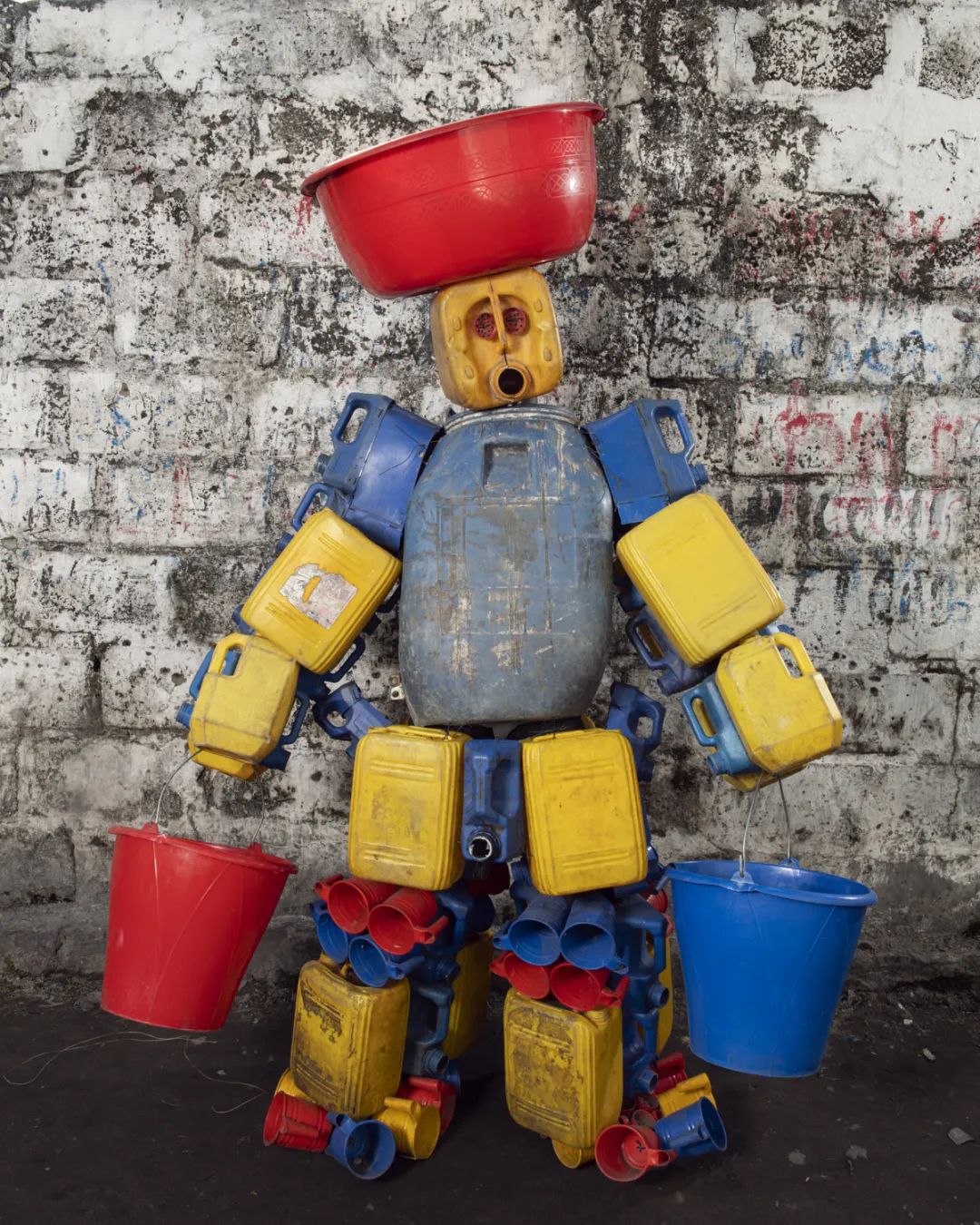贫民窟垃圾堆里诞生艺术运动,刚果艺术团体急切呼吁环保问题
法国摄影师斯蒂芬·格拉迪厄(Stephan Gladieu)出生于 1969 年,80 年代亲历了美苏冷战的他从 20 岁就开始担当战地记者。这几年,斯蒂芬·格拉迪厄将镜头转向社会人文,他来到刚果民主共和国的首都金沙萨 (Kinshasa),在街头拍下了一系列用垃圾废物制作的可穿戴雕塑装置,这是一场从贫民窟垃圾堆里诞生的震撼人心的艺术运动。
#01
金沙萨的自然正在消亡


▲《垃圾人(Homo Détritus)》系列作品之一,反映金沙萨缺水问题,图片来源:Stephan Gladieu
刚果民主共和国同时拥有着两个互相矛盾的身份,它既是“非洲第二大国家”,也是“地球上第八个最贫穷的国家”。这座国家的地下蕴藏着黄金、钶钽铁矿、钻石、钴、石油等丰富的资源,但这导致发达国家对其无节制的开采,在金沙萨的河流里,不仅流淌着含有大量废弃矿物的河水,也飘荡着无数塑料瓶。截至 2020 年,当地只有 30%的人能获得安全的饮用水。

▲ 纪录片《KINSHASA MAKAMBO》中拍摄的金沙萨街头的状况,图片来源:《KINSHASA MAKAMBO》
资源的过度开发并没有带来财富,利用刚果民主共和国的资源制成的产品往往到第三代、第四代诞生,成为工业化国家的废品时,才能重现于刚果民主共和国,这也加剧了垃圾污染。金沙萨是仅次于开罗和拉各斯的非洲第三大城市,2020 年时,每天有约 9 万吨垃圾在金沙萨产生,但能被处理的仅仅 2 万吨,剩余的都散布在城市中。
从民生经济的角度来看,2021 年,刚果民主共和国近 64%的人口每天的生活费不足 2 美元。近 65%的该国人口出生时的预期寿命仅为 48.7 岁,儿童入学率为 55%,其中 60%的人口年龄在 20 岁以下。


▲ 用易拉罐、塑料垃圾袋制作的艺术装置,图片来源:Stephan Gladieu
在刚果民主共和国,希腊悲剧大师欧里庇得斯的名句“土生土长”并没有实现,丰厚的地下资源仅仅只收获了遍地垃圾。在首都贫民窟的垃圾堆里,艺术挣扎起来向人们呼喊保护环境。
#02
艺术家们穿上金沙萨的垃圾
早在 2001 年,金沙萨美术学院的一群学生就发起了一场反文化艺术运动。他们放弃用树脂、石膏等常规材料制作装置,而拿起了身边随处可见的废弃物品——轮胎、排气管、泡沫、塑料瓶、天线、装牛奶或油漆的罐子、羽毛、cd、橡胶拖鞋等。年轻的艺术家们觉得这样的艺术品会让观众产生熟悉感,更重要的是反映了“浪费”问题。


▲ 在 Kinact 艺术节现场展示的艺术装置,图片来源:Kinact
这场反文化艺术运动直接而深刻地影响了十几年后金沙萨贫民窟艺术家的表达,2014 年 10 月诞生的 Kinact 艺术节中,就有艺术家开始用垃圾制作可穿戴的雕塑装置进行展示。2018 年 9 月,Kinact 艺术节的创始人埃迪·埃科特(Eddy Ekete)组织创立了艺术家团体“Ndaku ya la vie est belle”,即“生命之家是美丽的”。近 25 位艺术家加入了这个团体,他们有着不同的身份,埃迪·埃科特除了是视觉艺术家,也是整形师与活动家,此外还有歌手、音乐家、孤儿、受过伤的退伍军人等,其中大部分人曾就读于金沙萨美术学院。

▲《六天之泪(Matshozi 6 Jours》,图片来源:Kris Pannecoucke

▲ 沙卡·富穆·卡巴卡在他人帮助下穿戴装置,图片来源:Kris Pannecoucke
出生于 1988 年的沙卡·富穆·卡巴卡(Shaka Fumu Kabaka)就曾是金沙萨美术学院的学生。2000 年 6 月,乌干达和卢旺达的军队在他的家乡北部小城基桑加尼(Kisangani)进行了长达 6 天的对战,两个外部国家的纷争让上千名当地人丧命,年仅 12 岁的沙卡·富穆·卡巴卡也在这场战争里失去了亲人。
这种伤害一直持续到他成年后的人生,沙卡·富穆·卡巴卡说:“每次我到街上看到遍地是破烂的洋娃娃时,都会想起在基桑加尼发生的事情,它们象征着我亲眼所见的受害者”。沙卡·富穆·卡巴卡用一年的时间收集了废弃的玩偶,染成血红色,制作成可穿戴的艺术装置。他给这件作品取名为“六天之泪(Matshozi 6 Jours)”,纪念儿时那场为期六天的战争的受害者。
沙卡·富穆·卡巴卡说:“第一次穿这套服装时,我感觉负担沉重。不是因为重量,而是它所代表的伤亡人数。”

▲ Covid-19 套装,图片来源:Stephan Gladieu
在疫情时代,沙卡·富穆·卡巴卡还用废弃的牙膏管制作了一件带防毒面罩的防护服,第一次穿着这件“衣服”走在金沙萨的街头时,就有孩子对着他大喊“新冠!新冠!”这件艺术装置也因此被命名为“Covid-19 套装”。

▲ 用塑料圆环制作的艺术装置,图片来源:Stephan Gladieu
类似的是,艺术家阿诺德·埃塔贝(Arnold Etabe)也用一件由无数鲜艳塑料圆环组成的装置代表病毒。
▲《可怜的我(Kiadi Kibeni)》,图片来源:Stephan Gladieu
最开始吸引法国摄影师斯蒂芬·格拉迪厄前往金沙萨拍摄这些艺术装置的是艺术家莎拉·恩德勒(Sarah N'dele)的作品《可怜的我(Kiadi Kibeni)》,遍布全身的彩色塑料容器即使隔着社交媒体模糊的像素也让斯蒂芬·格拉迪厄震惊。他很快联系了莎拉·恩德勒,接触到艺术家团体“Ndaku ya la vie est belle”,开始拍摄这些艺术作品,并为这个项目取名《垃圾人(Homo Détritus)》系列。

▲《电女(Femme Électrique)》,图片来源:Stephan Gladieu
法隆·曼布(Falonne Mambu)是一位年轻的女性艺术家,她以自己无家可归的生活经历为灵感,用废弃的电线、插线板等创作了装置《电女(Femme Électrique)》。
法隆·曼布曾穿着她的装

▲《羽毛人(The Feather Man)》,图片来源:Stephan Gladieu

▲《轮胎人(Tire Man)》,图片来源:Stephan Gladieu
艺术家们用这些垃圾创作雕塑和表演艺术,希望强烈的视觉冲击能提高公众对环境危机的敏锐度。艺术表达往往是讽刺意味浓厚的,艺术家黑暗学者(Savant Noir)将象征祖先的羽毛粘满西服,嘲讽猖獗的消费主义。他的另一件作品《轮胎人(Tire Man)》用撕碎的轮胎组成,抗议刚果民主共和国数百年来对自然资源的消耗,其中就包括使用橡胶制造轮胎。


▲《人字拖人(Flip-Flop Man)》,图片来源:Stephan Gladieu

▲ 用破碎的镜子制作的艺术装置,图片来源:Stephan Gladieu
帕特里克·凯特(Patrick Kitete)的《人字拖人(Flip-Flop Man)》也和橡胶资源相关,廉价的人字拖像礼服裙一样覆盖了艺术家全身。他的“镜面人”则是穿着三件套西装的花花公子,“破碎的镜子反映了西方强加给刚果民主共和国的一切,以及它所摧毁的生活”。

▲ 由无线电部件制成的《机器人宣言(Robot Annonce)》,图片来源:Stephan Gladieu
卡伦噶·卡班古·贾里德(Kalenga Kabangu Jared)经常穿着他的《机器人宣言(Robot Annonce)》走上街头,这套装置用无线电部件做成,艺术家希望通过它提高人们对假新闻不断蔓延的认识。“人们接收了太多不准确的信息,许多错误信息被广泛传播,我想与之抗争到底。”

▲《橡胶人(L'Homme Caoutchouc)》,图片来源:Stephan Gladieu

▲《高脚杯人(The Goblet Man)》,图片来源:Stephan Gladieu

▲《瓶盖武士(Cork Warrior Man)》,图片来源:Stephan Gladieu
拍摄这个《垃圾人》系列,斯蒂芬·格拉迪厄选择了一种幽默的、诗意的方式去吸引人们的注意力,他并不想创作一个悲惨的摄影系列去谴责一个国家的现状,而是更愿意恢复每个被拍者的尊严。在斯蒂芬·格拉迪厄的镜头里,每个艺术家都作为居民代表他所在的社会,而不是被变作符号。

▲《袋子人(L'Homme Sachet)》,图片来源:Stephan Gladieu

▲《剃刀人(Chaka)》,图片来源

▲《领带男(Homme Cravatte)》,图片来源:Stephan Gladieu
斯蒂芬·格拉迪厄也用一段非常诗意的文字描述了这些艺术家和艺术装置:“他们有点像幽灵,终于走出了这些社区,满身都是我们的垃圾。与此同时,他们重新诠释了我们殖民者试图摧毁的万物有灵论的面具。”
资料来源:
1.National Geographic Society《These artists transform garbage into garb to take a stand》
https://www.nationalgeographic.com/environment/article/these-artists-transform-garbage-into-garb-to-take-a-stand
2.Blind Magazine《The Superheroes of Beautiful Kinshasa》
https://www.blind-magazine.com/news/the-superheroes-of-beautiful-kinshasa/
3.Colossal《Photographer Stéphan Gladieu Documents the Congolese Street Children Turning Waste into Wonder》
https://www.thisiscolossal.com/2022/09/stephan-galdieu-homo-detritus/
4.https://www.stephangladieu.fr/homo-detritus/
5.https://eddyeketeblog.wordpress.com/
6.https://www.krispannecoucke.org/kinshasa-street-artists
7.The Guardian《‘They call us bewitched’: the DRC performers turning trash into art – photo essay》
https://www.theguardian.com/global-development/2021/aug/20/they-call-us-bewitched-the-drc-performers-turning-trash-into-art-photo-essay
8.WasteAid《Even something of little value has value: researching, identifying and scaling new technologies in the Democratic Republic of Congo》
https://wasteaid.org/even-something-of-little-value-has-value-researching-identifying-and-scaling-new-technologies-in-the-democratic-republic-of-congo/
9.http://www.kinact.org/
